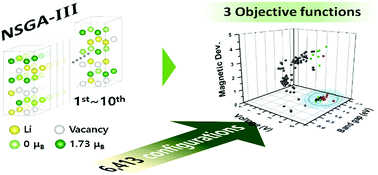Determination of possible configurations for Li0.5CoO2 delithiated Li-ion battery cathodes via DFT calculations coupled with a multi-objective non-dominated sorting genetic algorithm (NSGA-III)†
Abstract
Here, we propose a new and logical approach to systematically treat the configurational diversity in density functional theory (DFT) calculations. To tackle this issue, we select Li0.5CoO2 as a representative example because it is one of the most extensively studied cathodes in Li-ion batteries (LIBs), and it has a huge number of disordered configurations. To delineate the configurations that will match well with the experimentally measured macro-functions of redox potential, band gap energy, and magnetic moment, we adopt a multi-objective, non-dominated sorting, genetic algorithm (NSGA-III) that enables the simultaneous optimization of these three objective functions. The decision variables include configuration of the Li/vacancy, initial input for the magnetic moment distribution reflecting Co3+/Co4+ distribution, and initial input for the lattice parameter and Hubbard U. We use NSGA-III to separate the configurations that exhibit awkward objective function values, which allows us to pinpoint a set of plausible configurations that match the experimentally estimated values of the objective functions. The results reveal a plausible configuration that is a mixture of various ordered/disordered configurations rather than a simple ordered structure.



 Please wait while we load your content...
Please wait while we load your content...